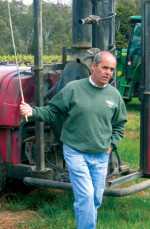Maximize Potential With Your Sprayers

Over the years, some growers have invested in new equipment while others are trying to use older sprayers to get the job done. While new spraying equipment, in general, is going to increase efficiencies, oftentimes, growers can accurately apply a crop protectant using their existing equipment if they make improvements to it.
American Vegetable Grower (AVG) caught up with Andrew Landers, a pesticide application technology specialist at Cornell University, to discuss the benefits of improving equipment and the sprayer components growers should consider updating.
Q. Why should growers modernize their existing sprayer or purchase a new machine?
Landers: Three factors play into why growers need to consider purchasing an advanced spraying system or add electronic controls to their existing equipment. Those factors are economics, efficiency, and traceability. The first factor, economics, has to do with the cost involved in operating the equipment. The equipment is expensive, labor is expensive and, as far as I know, the cost of pesticides never goes down. In addition, I think we have forgotten that not too long ago, diesel fuel fetched nearly $5 a gallon. When I speak with growers about how much they spend on fuel, it is a staggering amount of money.
The second factor is efficiency, and efficiency equals accuracy. We need to be accurate. We want the products to work well. In particular, I focus on nozzles and boom stability, which give us accuracy.
The third factor, traceability, is becoming increasingly more important. Growers need to accurately apply pesticides. As we’ve had several food safety scares in the last several years, there will be more of a focus on traceability, especially if we look at it from a global perspective.
Q. What are the top five sprayer components that growers should consider purchasing?
Landers: The top five sprayer components include nozzles, calibration, boom suspension, engineering controls, and electronics.
1. Nozzles. You can either buy a new sprayer with wonderful gadgets or you can improve your existing sprayer. Nozzle selection, which leads into accuracy as well as spray quality, can help. We are seeing a lot of new nozzle development such as the air induction, twin fluid, and the Capstan Ag Systems and Wilger Industries, Ltd. nozzle systems. The Capstan and Wilger nozzle systems allow operators to change the operating parameter for different crops. Individual nozzles can be switched on or off, and in conjunction with GPS, allows nozzles to switch off as the headland mark is crossed on irregular shaped fields.
2. Calibration. All the growers I meet always tell me they don’t calibrate their sprayers because it takes too long. By calibrating the sprayer, the grower applies the correct amount of the chemical to the crop.
With the introduction of electronic calibration devices made by Innoquest Inc. and Wilger, the calibration process now can be handled rapidly. These electronic devices are placed under the nozzle, and in 15 seconds an accurate flow reading is displayed.
3. Boom Suspension. When an old galvanized boom is driven over woodchuck holes and rocks, boom bounce is the result. The idea is for the boom to remain stable in order to maintain accuracy. Once the boom has lost stability, it doesn’t matter what nozzle you use. You are not going to make an accurate application of a pesticide. This can lead to over-application and in the days of traceability, this is not acceptable and is a waste of money.
4. Engineering Controls. An induction bowl that looks like a little toilet next to the sprayer allows the pesticides to be added to the tank without the applicator climbing on the spray rig. Using an induction bowl reduces operator contamination and reduces the risk of spilling the chemical.
In addition, advances in tank washing have created numerous efficiencies. These devices are built into the sprayer, and the grower can rinse the sprayer in the field as part of the spraying operation, which saves time. In-field tank washing devices also reduce the chance of point-source pollution when the grower goes back to the farm.
5. Electronics. In particular, devices that monitor flow are important. Some growers have high-tech sprayers and can switch off boom sections. Right now, though, I think the majority of growers aren’t buying high tech. Simple electronics that allow them to change droplet size can help achieve greater accuracy. An example of this is pulse width technology from Wilger and Lurmark, which offers pneumatically controlled nozzle bodies, in pairs of fours, allowing the operator to change nozzle size — and droplet size — and flow rate from a switch in a cab.
For more information on vegetable spraying and related technology, visit Dr. Landers’ website here.










